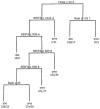Bayesian classification and regression trees for predicting incidence of cryptosporidiosis
- PMID: 21909377
- PMCID: PMC3166077
- DOI: 10.1371/journal.pone.0023903
Bayesian classification and regression trees for predicting incidence of cryptosporidiosis
Abstract
Background: Classification and regression tree (CART) models are tree-based exploratory data analysis methods which have been shown to be very useful in identifying and estimating complex hierarchical relationships in ecological and medical contexts. In this paper, a Bayesian CART model is described and applied to the problem of modelling the cryptosporidiosis infection in Queensland, Australia.
Methodology/principal findings: We compared the results of a Bayesian CART model with those obtained using a Bayesian spatial conditional autoregressive (CAR) model. Overall, the analyses indicated that the nature and magnitude of the effect estimates were similar for the two methods in this study, but the CART model more easily accommodated higher order interaction effects.
Conclusions/significance: A Bayesian CART model for identification and estimation of the spatial distribution of disease risk is useful in monitoring and assessment of infectious diseases prevention and control.
Conflict of interest statement
Figures



Similar articles
-
Risk factor analysis and spatiotemporal CART model of cryptosporidiosis in Queensland, Australia.BMC Infect Dis. 2010 Oct 28;10:311. doi: 10.1186/1471-2334-10-311. BMC Infect Dis. 2010. PMID: 21029426 Free PMC article.
-
Spatial analysis of notified cryptosporidiosis infections in Brisbane, Australia.Ann Epidemiol. 2009 Dec;19(12):900-7. doi: 10.1016/j.annepidem.2009.06.004. Epub 2009 Aug 3. Ann Epidemiol. 2009. PMID: 19648028
-
The use of ZIP and CART to model cryptosporidiosis in relation to climatic variables.Int J Biometeorol. 2010 Jul;54(4):433-40. doi: 10.1007/s00484-009-0294-4. Epub 2010 Jan 19. Int J Biometeorol. 2010. PMID: 20084521
-
Climate variability, socio-ecological factors and dengue transmission in tropical Queensland, Australia: A Bayesian spatial analysis.Environ Res. 2021 Apr;195:110285. doi: 10.1016/j.envres.2020.110285. Epub 2020 Oct 4. Environ Res. 2021. PMID: 33027631
-
A comparison of conditional autoregressive models used in Bayesian disease mapping.Spat Spatiotemporal Epidemiol. 2011 Jun;2(2):79-89. doi: 10.1016/j.sste.2011.03.001. Epub 2011 Mar 12. Spat Spatiotemporal Epidemiol. 2011. PMID: 22749587 Review.
Cited by
-
Global climate change-driven impacts on the Asian distribution of Limassolla leafhoppers, with implications for biological and environmental conservation.Ecol Evol. 2024 Jul 18;14(7):e70003. doi: 10.1002/ece3.70003. eCollection 2024 Jul. Ecol Evol. 2024. PMID: 39026963 Free PMC article.
-
A diagnostic model for minimal change disease based on biological parameters.PeerJ. 2018 Jan 12;6:e4237. doi: 10.7717/peerj.4237. eCollection 2018. PeerJ. 2018. PMID: 29340242 Free PMC article.
-
Risk assessment of dengue fever in Zhongshan, China: a time-series regression tree analysis.Epidemiol Infect. 2017 Feb;145(3):451-461. doi: 10.1017/S095026881600265X. Epub 2016 Nov 22. Epidemiol Infect. 2017. PMID: 27873572 Free PMC article.
-
Application of Bayesian Decision Tree in Hematology Research: Differential Diagnosis of β-Thalassemia Trait from Iron Deficiency Anemia.Comput Math Methods Med. 2021 Nov 9;2021:6401105. doi: 10.1155/2021/6401105. eCollection 2021. Comput Math Methods Med. 2021. PMID: 34795791 Free PMC article.
-
A novel differential diagnostic model based on multiple biological parameters for immunoglobulin A nephropathy.BMC Med Inform Decis Mak. 2012 Jun 27;12:58. doi: 10.1186/1472-6947-12-58. BMC Med Inform Decis Mak. 2012. PMID: 22738421 Free PMC article.
References
-
- Meinhardt P, Casemore D, Miller K. Epidemiologic aspects of human cryptosporidiosis and the role of waterborne transmission. Epidemiol Rev. 1996;18:118–136. - PubMed
-
- Moore D, Carpenter T. Spatial analytical methods and geographic information systems: use in health research and epidemiology. Epidemiol Rev. 1999;21:143–161. - PubMed
-
- Anselin L. Under the hood - Issues in the specification and interpretation of spatial regression models. Agric Econo. 2002;27:247–267.
-
- Anselin L. Exploring spatial data with GeoDa: a workbook. Urbana, USA.: 2005.

